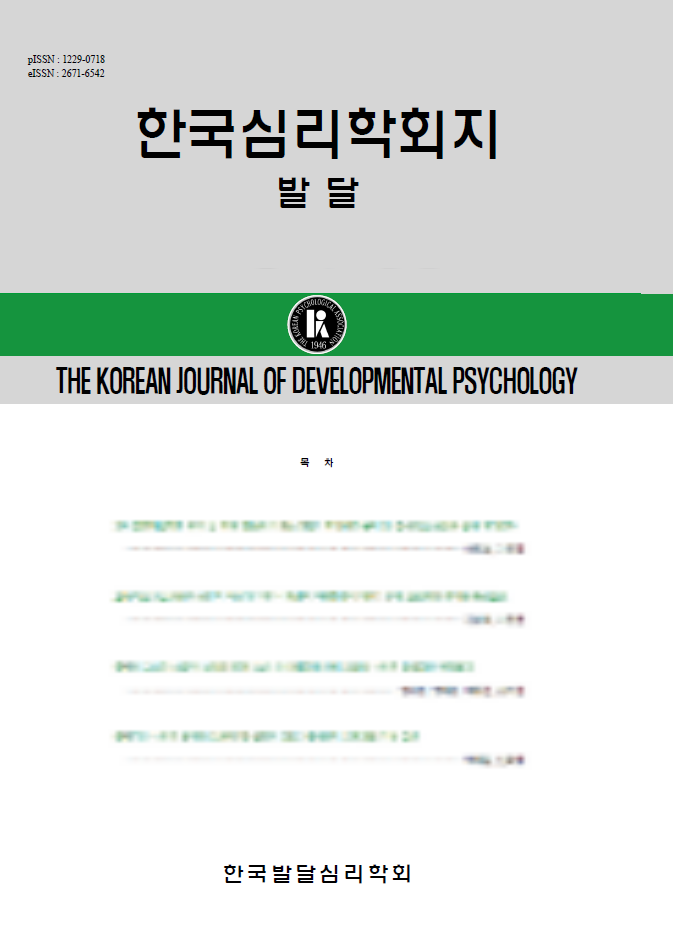open access
메뉴
open access
메뉴 ISSN : 1229-0718
ISSN : 1229-0718

본 연구는 한국어를 모국어로 사용하는 아동들이 새로운 동사의 의미를 파악할 때 문장 구조 정보를 활용하는지 알아보고자 하였다. 만 24개월 아동(실험 1)과 만 21개월 아동(실험 2)이 새로운 동사가 포함된 문장을 들으면서 문장의 초두에 있는 명사에 주격 또는 목적격 조사가 있는지 여부에 따라 새로운 동사가 포함된 문장의 의미 이해가 달라지는지를 보고자 하였다. 실험 결과 24개월 아동들은 목적격 조사 조건(예: 호랑이를 수비고 있네)에서는 문장이 장면에 등장한 동물들 간의 인과적 행동을 지시하는 것으로 이해하였으나 주격 조사 조건(예: 호랑이가 수비고 있네)에서는 그러한 양상이 나타나지 않았다. 반면 21개월 아동들의 문장 이해는 문장 초두의 명사에 수반된 조사의 유형에 의해 영향을 받지 않았다. 실험 3에서는 21개월 아동들이 격조사가 생략된 하나의 명사가 포함된 문장(예: 돼지 루디고 있다) 또는 두 개의 명사가 포함된 문장(예: 호랑이 돼지 루디고 있다)을 어떻게 이해하는지 살펴보았다. 실험 결과 21개월 아동들은 두 개의 명사가 포함된 문장은 언급된 동물들 간의 인과적 행동으로 이해하였지만, 한 개의 명사만 포함된 문장에 대해서는 그러한 이해를 보이지 않았다. 본 연구는 한국 아동들이 새로운 동사가 포함된 문장의 의미를 이해할 때 활용하는 단서 유형 발달에 대한 경험적 증거를 제공한다.
The present study used a preferential looking paradigm to examine the types of structural cues used by 24- and 21-months-old Korean children when processing the meaning of sentences with a novel verb in Korean. In the first two of the three experiments, participants were shown two videos positioned adjacent to each other, depicting independent or causative behaviors, and were made to listen to sentences with a nominative or accusative case marker. It was found that in Experiment 1, the 24-month-old infants looked at causative rather than independent behaviors for longer in the accusative condition, but not in the nominative condition. In Experiment 2, the 21-month old infants looked at independent behaviors for longer durations regardless of the sentence type. In Experiment 3, one- and two-noun sentences were used without any case markers. The 21-month old infants looked at causative behaviors for longer when hearing two-noun rather than one-noun sentences. These results suggest that by the age of 24 months, Korean children use morphological cues when understanding the meaning of a novel verb, while younger children might exploit the number of noun cues rather than case markers.
송현주, 최유정, 김민영 (2008). 한국어에서 담화 정보가 학령 전 아동의 문장 이해에 미치는 영향. 한국심리학회지: 발달, 21(3), 81-97.
이우열, 송현주 (2009). 형태론적 단서가 만 2세 아동의 새로운 동사학습에 미치는 영향. 한국심리학회지: 발달, 22(4), 111-123.
이윤하, 송현주 (2010a). 한국 아동의 조사를 이용한 새로운 명사 학습. 한국심리학회지: 발달, 23(1), 103-117.
이윤하, 송현주 (2010b). 한국 아동과 성인의 처소격 조사를 활용한 공간 명사의 의미 이해. 한국심리학회지: 발달, 23(4), 17-31.
최영은 (2010). 한국어 복합 동사 습득 기제 연구. 한국심리학회지: 발달, 23(3), 125- 139.
Choi, S. (2000). Caregiver input in English and Korean: use of nouns and verbs in book-reading and toy-play contexts. Journal of Child Language, 27(1), 69-96.
Clancy, P. (2009). The acquisition of argument structure and transitivity in Korean: A discourse-functional approach. In P. Li (ed.), Handbook of East Asian Psycholinguistics, part Ⅲ: Korean Psycholinguistics, C. Lee, Y. Kim, and G. Simpson (eds.). London: Cambridge University Press.
Fernandes, K. J., Marcus, G. F., Nubila, J. A., & Voulumanos, A. (2006). From semantics to syntax and back again: Argument structure in the third year of life. Cognition 100, B10-B20.
Fisher, C. (1996). Structural limits on verb mapping: The role of analogy in children's interpretations of sentences. Cognitive Psychology, 31(1), 41-81.
Fisher, C., Gertner, Y., Scott, R. M., & Yuan, S. (2010). Syntactic bootstrapping. Wiley Interdisciplinary Reviews: Cognitive Science, 1, 143-149.
Fisher, C., Klingler, S. L., Song, H. (2006). What does syntax say about space? 2-year-olds use sentence structure to learn new prepositions. Cognition, 101(1), B19-B29.
Gleitman, L., Cassidy, K., Nappa, R., Papafragou, A., & Trueswell, J. C. (2005). Hard words. Language Learning and Development, 1(1), 23-64.
Göksun, T., Küntay, A. C., & Naigles, L. (2008). Turkish children use morphosyntactic bootstrapping in interpreting verb meaning. Journal of Child Language, 35, 291-323.
Hirsh-Pasek, K., & Golinkoff, R. (1996). The origins of grammar: Evidence from early language comprehension. Cambridge, MA: MIT Press.
Imai, M., Li, L., Haryu, E., Okada, H., Hirsh-Pasek, K., Golinkoff, R., & Shigematsu, J. (2008). Novel noun and verb learning in Chinese-, English-, and Japanese-speaking children. Child Development, 79, 979-1000.
Landau, B., & Gleitman, L. (1985). Language and experience: evidence from the blind child. Cambridge, MA: Harvard University Press.
Lee, J. N., & Naigles, L. R. (2008). Mandarin learners use syntactic bootstrapping in verb acquisition. Cognition, 106(2), 1028-1037.
Lidz, J., Gleitman, H., & Gleitman, L. (2003). Understanding how input matters: verb learning and the footprint of universal grammar. Cognition, 87(3), 151-178.
Matsuo, A., Kita, S., Shinya, Y., Wood, G. C., & Naigles, L. (2012). Japanese two-year-olds use morphosyntax to learn novel verb meanings. Journal of Child Language, 39(3), 637-663.
Naigles, L. R. (1990). Children use syntax to learn verb meanings. Journal of Child Language, 17, 357-374.
Naigles, L. G., & Kako, E. T. (1993). First Contact in Verb Acquisition: Defining a Role for Syntax. Child Development, 64(6), 1665- 1687.
Song, H. & Fisher, C. (2005). Who's “she”? Discourse prominence influences preschoolers' comprehension of pronouns. Journal of Memory and Language, 52, 29-57.
Song, H., & Fisher, C. (2007). Discourse promience effects on 2.5-year-old children's interpretation of pronouns. Lingua, 117, 1959- 1987.
Yuan, S., & Fisher, C. (2009). “Really? She blicked the baby?”: Two-year-olds learn combinatorial facts about verbs by listening. Psychological Science, 20(5), 619-626.
Yuan, S., Fisher, C., & Snedeker, J. (2012). Counting the nouns: Simple structural cues to verb meaning. Child Development, 83(4), 1382- 1399.
